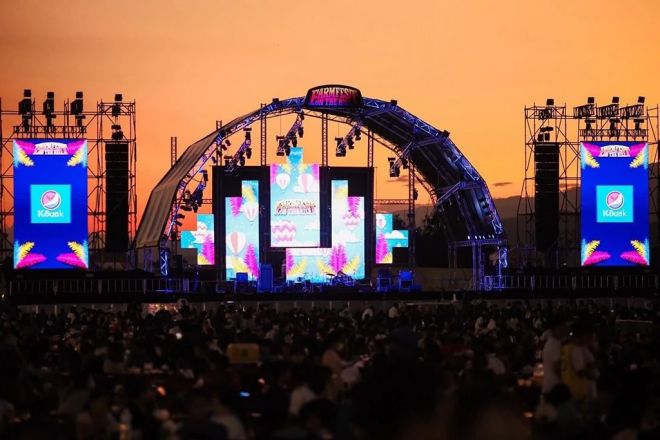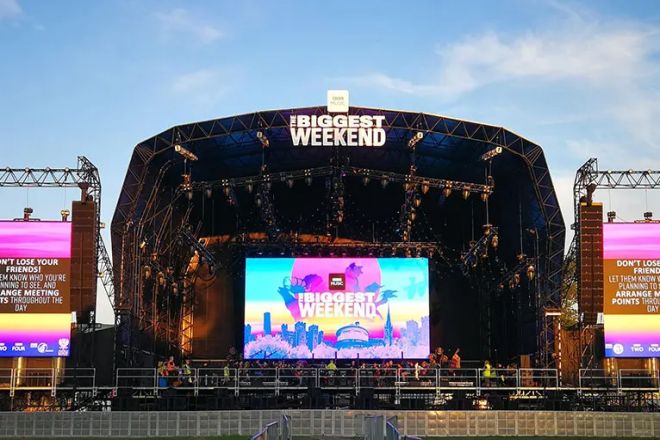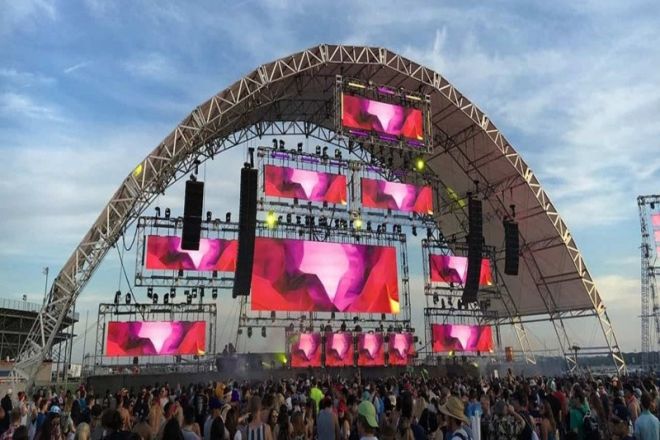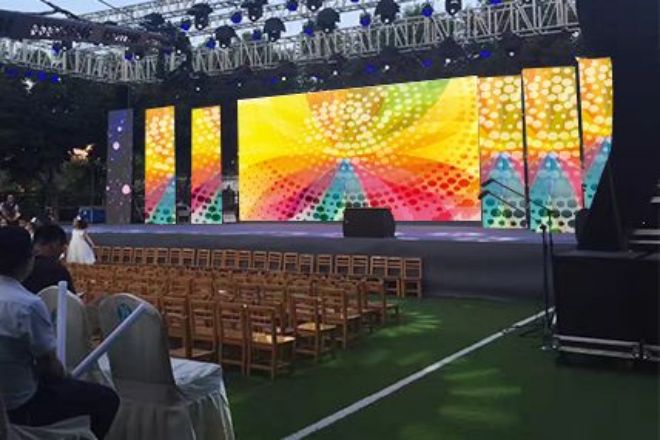Introducción

alquiler de pantallas led Se han utilizado ampliamente en espectáculos, exposiciones, conferencias y otras actividades gracias a su alta definición, colores brillantes y empalmes resistentes. Sin embargo, durante su uso, las pantallas LED de alquiler también presentan diversos problemas. Este artículo propone soluciones a problemas comunes con las pantallas LED de alquiler para garantizar el buen desarrollo de las actividades.
1. Problemas de visualización

1) Problemas que pueden surgir
1.1) Brillo desigual en las pantallas LED de alquiler
Descripción del fenómeno: Cuando se muestra la pantalla de alquiler de LED, el brillo de algunas áreas es significativamente más alto o más bajo que otras áreas, lo que genera un brillo desigual en toda la pantalla de alquiler de LED y afecta la experiencia de visualización.
Análisis de causa: Esta situación puede deberse al envejecimiento, daños o distribución desigual de las perlas de la lámpara LED, o a configuraciones de ajuste de brillo incorrectas.
1.2) Distorsión de color o dominante de color
Descripción del fenómeno: Cuando se muestra la pantalla de alquiler de LED, el color presentado se desvía del color real, como rojizo o verdoso, lo que hace que el color de la imagen sea inexacto.
Análisis de causa: La distorsión o matiz de color puede deberse a una calibración de color inexacta, una configuración de color incorrecta de la fuente de señal o al envejecimiento de las perlas de la lámpara LED.
1.3) La pantalla parpadea o tiembla
Descripción del fenómeno: Cuando se muestra la pantalla de alquiler de LED, la pantalla parpadea o tiembla rápidamente, lo que genera una sensación de inestabilidad en las personas y afecta el efecto de visualización.
Análisis de causa: Los parpadeos o temblores de la pantalla pueden deberse a una fuente de señal inestable, una interferencia en la línea de transmisión o una configuración incorrecta de la frecuencia de actualización de la pantalla LED de alquiler.
1.4) Pantalla negra o pantalla de flores
Descripción del fenómeno: Cuando se muestra la pantalla de alquiler de LED, aparece una pantalla negra o una pantalla de flores en parte o en todas las áreas y el contenido no se puede mostrar normalmente, lo que afecta gravemente la experiencia de visualización.
Análisis de causa: La pantalla negra o pantalla de flores puede deberse a una línea de conexión suelta de la pantalla LED de alquiler, una interfaz dañada, una falla en la fuente de señal o problemas de hardware de la pantalla LED de alquiler.
2) Soluciones a los problemas de visualización de las pantallas LED de alquiler
2.1) Soluciones para el brillo desigual de la pantalla LED de alquiler
Ajuste la configuración de brillo de la pantalla de alquiler LED: Según la situación real, ajuste el brillo general o la configuración de brillo local de la pantalla de alquiler LED para garantizar una distribución uniforme del brillo en cada área.
Compruebe el estado de las perlas de la lámpara LED: Verifique periódicamente el estado de funcionamiento de las perlas de la lámpara LED y reemplace las perlas de la lámpara viejas o dañadas a tiempo.
Calibración de brillo: Calibre el brillo general de la pantalla LED de alquiler para garantizar una distribución uniforme del brillo de la pantalla LED de alquiler durante la visualización.
2.2) Soluciones para la distorsión o dominante de color
Calibración de color: Utilice herramientas profesionales de calibración de color para calibrar la pantalla LED de alquiler para garantizar la precisión del color de la pantalla LED de alquiler.
Ajuste la configuración de color de la fuente de señal: Según la situación real, ajuste la configuración de color de la fuente de señal para que coincida con el rendimiento del color de la pantalla de alquiler LED.
Reemplace las perlas de la lámpara viejas: Verifique regularmente el estado de las perlas de la lámpara LED y reemplácelas a tiempo si se encuentra que están viejas para mantener la precisión del color.
2.3) Soluciones al parpadeo o vibración de la pantalla
Compruebe la estabilidad de la fuente de señal: Asegúrese de que la fuente de señal funcione de manera estable para evitar parpadeos o vibraciones en la pantalla debido a problemas con la fuente de señal.
Compruebe la línea de transmisión: Verifique si la línea de transmisión está interferida o dañada y tome medidas antiinterferentes o reemplace la línea de transmisión si es necesario.
Ajustar la frecuencia de actualización de la pantalla de alquiler LED: De acuerdo con las características de la fuente de señal, ajuste la configuración de la frecuencia de actualización de la pantalla de alquiler LED para asegurarse de que coincida con la fuente de señal y evite problemas de parpadeo.
2.4) Soluciones para la pantalla negra o la pantalla de flores
Compruebe las líneas de conexión y las interfaces: Asegúrese de que las líneas de conexión y las interfaces de la pantalla LED de alquiler estén firmemente conectadas sin holgura ni daño.
Compruebe la fuente de la señal: Verifique si la fuente de señal está funcionando correctamente y elimine el problema de la pantalla negra o la pantalla de flores causado por una falla en la fuente de señal.
Reparar o reemplazar hardware: Si la inspección detecta que existen problemas con el hardware de la pantalla LED de alquiler, como la placa de control, la placa del controlador, etc., se debe reparar o reemplazar a tiempo para restaurar la función de visualización normal de la pantalla LED de alquiler.
2. Problemas eléctricos
1) Problemas que pueden surgir
1.1) Suministro de energía inestable o insuficiente
Este problema puede ser causado por fluctuaciones en la red eléctrica externa, atenuación de voltaje debido a líneas de suministro de energía demasiado largas o envejecimiento o daño de los equipos de suministro de energía (como transformadores, rectificadores, etc.).
Un suministro de energía insuficiente puede provocar una degradación del rendimiento del equipo, un funcionamiento inestable o incluso daños.
1.2) Envejecimiento de la línea o cortocircuito
El envejecimiento de la línea puede provocar la degradación del material de aislamiento debido al uso a largo plazo y a factores ambientales (como alta temperatura, humedad, corrosión, etc.).
Los cortocircuitos pueden ser causados por daños en la línea, contacto de metal expuesto, daños a los componentes eléctricos, etc., lo que puede tener consecuencias graves como daños en el equipo e incendios.
1.3) Fallo de componente eléctrico
La falla de un componente eléctrico puede incluir daños o fallas de componentes como interruptores, enchufes, relés, disyuntores, motores, transformadores, etc.
Los componentes eléctricos defectuosos pueden provocar que el equipo no funcione correctamente o incluso provocar accidentes de seguridad.
2) Soluciones a problemas eléctricos
Utilice una fuente de alimentación estable y equípela con una fuente de alimentación UPS para garantizar el suministro de energía.
Elija un proveedor de energía estable para garantizar la calidad del suministro de energía de la red eléctrica externa.
Para equipos o sistemas clave, equipar UPS (sistema de alimentación ininterrumpida) o EPS (sistema de alimentación de emergencia) para proporcionar energía temporal cuando se interrumpe la red eléctrica para garantizar el funcionamiento normal del equipo.
Verifique periódicamente el estado de la batería de los equipos UPS/EPS y reemplace las baterías viejas a tiempo.
Revise periódicamente las líneas y reemplace los cables viejos o dañados a tiempo.
Desarrollar un plan de inspección regular, que incluya inspección visual, pruebas de rendimiento eléctrico, etc.
Si se encuentran cables envejecidos y dañados, reemplácelos con cables que cumplan con las especificaciones a tiempo.
Los cables utilizados en entornos especiales (como alta temperatura, humedad, corrosión, etc.) deben seleccionarse con cables con niveles de protección correspondientes.
Equipar a ingenieros eléctricos profesionales para inspeccionar y mantener componentes eléctricos.
Contratar ingenieros eléctricos profesionalmente calificados para realizar inspecciones y mantenimiento regulares de los componentes eléctricos.
Para los componentes eléctricos que se encuentren defectuosos, reemplácelos o repárelos a tiempo para garantizar el funcionamiento normal del equipo.
Establecer un archivo de registro de mantenimiento de los componentes eléctricos para realizar un seguimiento de la vida útil y el mantenimiento de los componentes.
3) Sugerencias adicionales
Establecer un sistema de gestión de seguridad eléctrica: aclarar los procesos y requisitos para la operación, inspección y mantenimiento de equipos eléctricos para garantizar la estandarización y la eficacia de la gestión de la seguridad eléctrica.
Fortalecer la capacitación en seguridad eléctrica: realizar periódicamente capacitaciones en seguridad eléctrica para los empleados para mejorar su conocimiento de seguridad y sus habilidades operativas.
Instalar dispositivos de protección eléctrica, como protectores contra sobrecargas, protectores contra fugas, dispositivos de protección contra rayos, etc., para reducir el impacto de las fallas eléctricas en los equipos y el personal.
Desarrollar planes de emergencia: formular planes de emergencia ante posibles fallas eléctricas o accidentes, aclarar los procesos de respuesta a emergencias y las personas responsables, y garantizar que puedan responder rápida y eficazmente en caso de fallas eléctricas o accidentes.
3. Problemas estructurales

1) Problemas que pueden surgir
- Soportes o fijaciones inestables
Los soportes o accesorios inestables pueden provocar que la pantalla LED de alquiler se mueva, se incline o incluso se caiga, lo que afecta gravemente el funcionamiento normal del equipo y la seguridad del personal.
Las razones de la inestabilidad pueden incluir un diseño de soporte poco razonable, una instalación floja, mala calidad del material, etc.
- El espacio entre los empalmes es demasiado grande o desigual.
El espacio entre las uniones es demasiado grande o desigual, lo que afectará el efecto visual de la pantalla LED de alquiler y reducirá la experiencia visual de la audiencia.
Las razones por las que el espacio es demasiado grande o desigual pueden incluir una tecnología de empalme deficiente, diferencias en los materiales de la pantalla LED de alquiler, ajustes de instalación inadecuados, etc.
- El tamaño de la pantalla LED de alquiler no coincide con el entorno de instalación.
El tamaño de la pantalla LED de alquiler no coincide con el entorno de instalación, lo que puede causar problemas como proporciones de imagen desequilibradas, efectos visuales deficientes o espacio de instalación insuficiente.
Las razones de la falta de coincidencia pueden incluir mediciones inexactas, cambios en el entorno de instalación y selección incorrecta del tamaño de la pantalla LED de alquiler.
2) Soluciones a problemas estructurales
Utilice soportes y accesorios calificados para garantizar que la pantalla LED de alquiler sea estable.
Elija soportes y accesorios certificados y confiables para garantizar que el diseño del soporte sea razonable y el material sea sólido.
Durante el proceso de instalación, siga la guía de instalación y los pasos del soporte para asegurarse de que el soporte y el accesorio estén instalados de manera firme y estable.
Compruebe periódicamente la estabilidad del soporte y del accesorio para detectar y reparar posibles problemas a tiempo.
Ajuste periódicamente la pantalla LED de alquiler para reducir los espacios y mejorar la uniformidad.
En el caso de las pantallas LED de alquiler empalmadas, se deben realizar ajustes de empalme periódicamente para garantizar que los espacios entre cada pantalla LED de alquiler sean lo más pequeños y uniformes posibles.
Durante el proceso de ajuste de empalme, se deben utilizar herramientas y técnicas profesionales para garantizar la precisión y la eficacia del ajuste.
Limpie y mantenga periódicamente la pantalla LED de alquiler para mantener la superficie de la pantalla LED de alquiler limpia y lisa, lo que ayudará a reducir los espacios y mejorar los efectos visuales.
Mida cuidadosamente el entorno de instalación antes de alquilar y elija el tamaño apropiado de la pantalla LED de alquiler.
Antes de alquilar o comprar una pantalla LED de alquiler, mida cuidadosamente el tamaño y la forma del entorno de instalación para comprender el espacio de instalación disponible y las restricciones.
De acuerdo con la situación real del entorno de instalación, seleccione el tamaño y la proporción adecuados de la pantalla de alquiler LED para garantizar que el tamaño de la pantalla de alquiler LED coincida con el entorno de instalación.
Si el entorno de instalación cambia o el tamaño de la pantalla de alquiler LED se selecciona incorrectamente, el tamaño de la pantalla de alquiler LED debe ajustarse o reemplazarse a tiempo para garantizar el mejor efecto visual y efecto de instalación.
3) Sugerencias adicionales
Tenga en cuenta la adaptabilidad ambiental: al seleccionar soportes y accesorios, considere su adaptabilidad ambiental, como resistencia a altas temperaturas, resistencia a la humedad, resistencia a la corrosión y otras características para adaptarse a diferentes entornos de instalación.
Elija marcas conocidas: elija productos de marcas conocidas; su calidad y rendimiento están más garantizados y el servicio posventa es más completo.
Siga la guía de instalación: durante el proceso de instalación, siga estrictamente la guía de instalación y los pasos del soporte y la pantalla LED de alquiler para garantizar la precisión y seguridad de la instalación.
Operadores de trenes: Brindar capacitación pertinente a los operadores para que comprendan la operación, el mantenimiento y las precauciones del equipo para mejorar la eficiencia operativa y la seguridad del equipo.
4. Problemas de funcionamiento
1) Problemas que pueden surgir
- La interfaz de operación es compleja y no es fácil de usar.
La interfaz de operación compleja puede provocar que los usuarios se confundan al utilizar el equipo o el software, lo que reduce la eficiencia del trabajo.
La interfaz de operación que no es fácil de usar puede deberse a que el diseño es demasiado engorroso, la disposición funcional no es razonable o carece de intuición.
- Problemas de compatibilidad de software
Los problemas de compatibilidad de software pueden provocar que el software no funcione normalmente o entre en conflicto con otro software y hardware.
Las causas de los problemas de compatibilidad pueden incluir versiones de software incompatibles, diferencias en el sistema operativo, controladores faltantes, etc.
- Fallo del sistema de control
Una falla del sistema de control puede provocar que el equipo no funcione normalmente, afectando la producción o el servicio normal.
Las causas de falla pueden incluir daños en el hardware, errores de software, problemas de red o errores humanos.
2) Medidas de resolución de problemas operativos
- Simplifique la interfaz de operación y proporcione guías de operación fáciles de usar
Rediseñar la interfaz de operación para hacerla más concisa e intuitiva y reducir funciones y pasos redundantes.
Proporcionar guías de operación detalladas y tutoriales para ayudar a los usuarios a familiarizarse rápidamente y dominar el uso del equipo o software.
Configure canales de retroalimentación de los usuarios, recopile opiniones y sugerencias de los usuarios de manera oportuna y optimice continuamente la interfaz de operación y las guías.
Pruebe la compatibilidad del software con antelación para garantizar un funcionamiento estable
Antes de lanzar el software, realice pruebas de compatibilidad suficientes, incluidas pruebas de diferentes sistemas operativos, diferentes versiones de software y diferentes configuraciones de hardware.
Resuelva posibles problemas de compatibilidad con antelación para garantizar que el software pueda ejecutarse de manera estable en diversos entornos.
Durante el uso del software, continúe prestando atención a los comentarios de los usuarios y a los informes de problemas, y solucione los problemas de compatibilidad conocidos de manera oportuna.
Equipar un equipo de soporte técnico profesional para solucionar fallas del sistema de control de manera oportuna.
Configurar un equipo de soporte técnico profesional para resolver los problemas que encuentren los usuarios durante el uso del equipo o software.
Proporcionar servicios de soporte técnico 24 horas al día, 7 días a la semana para garantizar que los usuarios puedan obtener ayuda a tiempo cuando encuentren fallas en el sistema de control.
Capacitar y mejorar periódicamente las habilidades del equipo de soporte técnico para garantizar que tengan la capacidad de resolver diversos problemas complejos.
Establecer un mecanismo completo de manejo y recuperación de fallas para garantizar que el funcionamiento normal del equipo o software pueda restaurarse rápidamente cuando ocurre una falla en el sistema de control.
3) Sugerencias adicionales
Proporcionar múltiples métodos de operación: para satisfacer las necesidades y hábitos de diferentes usuarios, se pueden proporcionar múltiples métodos de operación, como pantalla táctil, teclado, mouse, etc.
Optimizar la experiencia del usuario: seguir prestando atención a las necesidades y los comentarios de los usuarios, optimizar continuamente el diseño y las funciones del producto y mejorar la experiencia del usuario.
Fortalecer la capacitación de los usuarios: para equipos o software complejos, brindar cursos de capacitación de usuarios para ayudarlos a dominar mejor los métodos y habilidades de uso.
Establecer una comunidad de usuarios: establecer una comunidad o foro de usuarios para alentar a los usuarios a intercambiar experiencias de uso y resolver problemas juntos.
5. Problemas de transporte e instalación

1) Problemas que pueden surgir
- Daños en la pantalla LED de alquiler durante el transporte
La vibración, la colisión, la extrusión y otros factores durante el transporte pueden causar daños a la pantalla LED de alquiler.
Los daños pueden manifestarse como una pantalla LED de alquiler agrietada, componentes internos dañados o una estructura general deformada.
- Una instalación incorrecta provoca deformaciones o daños en la pantalla LED de alquiler.
El uso inadecuado durante la instalación, como el uso de herramientas inadecuadas, una fuerza desigual o una secuencia de instalación incorrecta, puede provocar deformaciones o daños en la pantalla LED de alquiler.
Un entorno de instalación inadecuado, como paredes irregulares, capacidad de carga insuficiente o selección incorrecta de la ubicación de instalación, también pueden causar problemas después de instalar la pantalla LED de alquiler.
- Soluciones a problemas de transporte e instalación
Elija una empresa de transporte profesional y tome medidas de protección efectivas.
Elija una empresa de transporte con amplia experiencia y buena reputación para garantizar la seguridad durante el transporte.
Antes del transporte, la pantalla LED de alquiler se empaqueta y fija en detalle, y se utilizan materiales y equipos de embalaje profesionales, como espuma a prueba de golpes, marcos de madera, etc., para reducir las vibraciones y las colisiones durante el transporte.
Durante el transporte, la pantalla LED de alquiler se monitorea y rastrea en tiempo real para garantizar la seguridad y la fluidez de la ruta de transporte.
- Haga un plan de instalación detallado antes de la instalación para garantizar que el proceso de instalación esté estandarizado.
Antes de la instalación, realice un estudio y una evaluación detallados del entorno de instalación para asegurarse de que la selección de la ubicación de instalación sea razonable, la pared sea plana y la capacidad de carga cumpla con los requisitos.
Según las características de la pantalla LED de alquiler y el entorno de instalación, se formula un plan de instalación detallado, que incluye los pasos de instalación, las herramientas necesarias, el personal, etc.
Durante el proceso de instalación, siga estrictamente el plan de instalación para garantizar que cada paso cumpla con las especificaciones y requisitos.
Equipado con un equipo de instalación profesional para garantizar la calidad y eficiencia de la instalación.
Elija un equipo de instalación con amplia experiencia y habilidades profesionales para garantizar la profesionalidad y precisión del proceso de instalación.
Realizar capacitaciones periódicas y actualizaciones técnicas para el equipo de instalación para que puedan dominar las últimas tecnologías y métodos de instalación.
Durante el proceso de instalación, se llevan a cabo una supervisión e inspección en tiempo real de la calidad de la instalación para garantizar que cada paso cumpla con los estándares y requisitos.
Una vez completada la instalación, la pantalla LED de alquiler se prueba y depura por completo para garantizar su funcionamiento normal y un buen efecto de visualización.
2) Sugerencias adicionales
Fortalecer la comunicación y la colaboración: durante el proceso de transporte e instalación, fortalezca la comunicación y la colaboración entre los distintos enlaces para garantizar un flujo de información fluido y el descubrimiento y la resolución oportunos de los problemas.
Desarrollar planes de emergencia: Desarrollar planes de emergencia y medidas de respuesta para posibles emergencias para garantizar que se pueda responder a ellas de manera rápida y efectiva cuando surjan problemas.
Brindar soporte técnico: una vez completada la instalación, brindar el soporte técnico y los servicios de mantenimiento necesarios para garantizar que la pantalla LED de alquiler pueda mantener las mejores condiciones durante su uso.
Mejora continua: De acuerdo con los comentarios de los usuarios y las condiciones reales, mejorar y optimizar continuamente el proceso de transporte e instalación para mejorar la calidad del servicio y la satisfacción del usuario.
Conclusión
Las pantallas LED de alquiler pueden presentar diversos problemas durante su uso, pero con las soluciones mencionadas, podemos resolverlos eficazmente y garantizar el buen desarrollo del evento. Además, para garantizar la estabilidad y seguridad de la pantalla LED de alquiler, se recomienda a los usuarios investigar y evaluar a fondo al proveedor antes de alquilarla y elegir proveedores con experiencia y tecnología profesional para colaborar.
Finalmente, si quieres saber más sobre las pantallas LED, Por favor póngase en contacto con nosotros.
